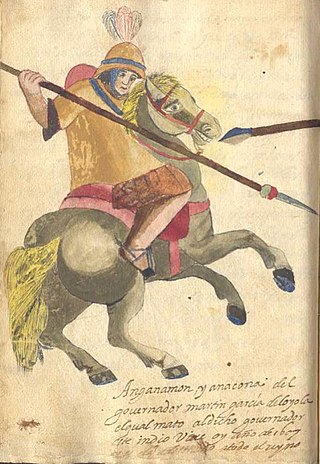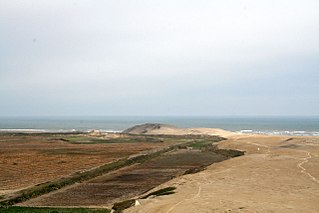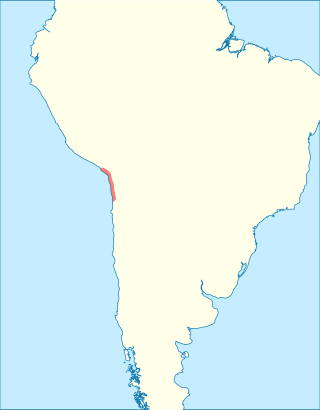Related Research Articles

Obsidian is a naturally occurring volcanic glass formed when lava extruded from a volcano cools rapidly with minimal crystal growth. It is an igneous rock.

Monte Verde is a Paleolithic archaeological site in the Llanquihue Province in southern Chile, located near Puerto Montt, Los Lagos Region. The site is primarily known for Monte Verde II, dating to approximately 14,550–14,500 calibrated years Before Present (BP). The Monte Verde II site has been considered key evidence showing that the human settlement of the Americas pre-dates the Clovis culture by at least 1,000 years. This contradicts the previously accepted "Clovis first" model which holds that settlement of the Americas began after 13,500 cal BP. The Monte Verde findings were initially dismissed by most of the scientific community, but the evidence then became more accepted in archaeological circles. The site also contains an older, much more controversial layer suggested to date to 18,500 cal BP, that lacks the general acceptance of Monte Verde II.

Austral University of Chile is a Chilean research university based primarily in Valdivia, with satellite campuses in Puerto Montt and Coyhaique. Founded on September 7, 1954, it is one of the eight original Chilean Traditional Universities. It operates as a nonprofit self-owned corporation under private law, and receives significant state-funding.

Paleo-Indians were the first peoples who entered and subsequently inhabited the Americas towards the end of the Late Pleistocene period. The prefix paleo- comes from the Ancient Greek adjective: παλαιός, romanized: palaiós, lit. 'old; ancient'. The term Paleo-Indians applies specifically to the lithic period in the Western Hemisphere and is distinct from the term Paleolithic.

Valdivia is a city and commune in southern Chile, administered by the Municipality of Valdivia. The city is named after its founder, Pedro de Valdivia, and is located at the confluence of the Calle-Calle, Valdivia, and Cau-Cau Rivers, approximately 15 km (9 mi) east of the coastal towns of Corral and Niebla. Since October 2007, Valdivia has been the capital of Los Ríos Region and is also the capital of Valdivia Province. The national census of 2017 recorded the commune of Valdivia as having 166,080 inhabitants (Valdivianos), of whom 150,048 were living in the city. The main economic activities of Valdivia include tourism, wood pulp manufacturing, forestry, metallurgy, and beer production. The city is also the home of the Austral University of Chile, founded in 1954 and the Centro de Estudios Científicos.

Osorno is a city and commune in southern Chile and capital of Osorno Province in the Los Lagos Region. It had a population of 145,475, as of the 2002 census. It is located 945 kilometres (587 mi) south of the national capital of Santiago, 105 kilometres (65 mi) north of the regional capital of Puerto Montt and 260 kilometres (160 mi) west of the Argentine city of San Carlos de Bariloche, connected via International Route 215 through the Cardenal Antonio Samoré Pass. It is a gateway for land access to the far south regions of Aysén and Magallanes, which would otherwise be accessible only by sea or air from the rest of the country.

Puyehue Lake, is an Andean piedmont lake on the border of Los Lagos Region with Los Ríos Region of Chile.

Tom Dalton Dillehay is an American anthropologist currently serving as the Rebecca Webb Wilson University Distinguished Professor of Anthropology, Religion, and Culture, as well as a Professor of Anthropology at Vanderbilt University. He has previously held teaching positions at the Universidad Austral de Chile and the University of Kentucky. Dillehay received his advanced degrees in anthropology from the University of Texas at Austin. He established anthropology departments at the Pontifical Catholic University of Chile in Temuco and at Austral University of Chile in Valdivia.

Zapaleri is a volcano whose summit is the tripoint of the borders of Argentina, Bolivia and Chile. A number of railways are in the area. It is part of Potosí Department (Bolivia), Jujuy Province (Argentina), and Antofagasta Region (Chile). The volcano formed on top of the 2.89 mya Tara Ignimbrite from the Guacha caldera and the basement beneath the volcano is formed from Cretaceous and Tertiary rocks affected by tectonic deformation. Volcanic rocks are andesite, basalt, dacite and rhyolite. Late Cretaceous rocks are also found in the area, as are Pleistocene shoshonite volcanic rocks.

Luzia Woman is the name for an Upper Paleolithic period skeleton of a Paleo-Indian woman who was found in a cave in Brazil. The 11,500-year-old skeleton was found in a cave in the Lapa Vermelha archeological site in Pedro Leopoldo, in the Greater Belo Horizonte region of Brazil, in 1974 by archaeologist Annette Laming-Emperaire.

The Destruction of the Seven Cities is a term used in Chilean historiography to refer to the destruction or abandonment of seven major Spanish outposts in southern Chile around 1600, caused by the Mapuche and Huilliche uprising of 1598. The Destruction of the Seven Cities, in traditional historiography, marks the end of the Conquest period and the beginning of the proper colonial period.

Since the mid-1990s, tourism in Chile has become one of the main sources of income for the country, especially in its most extreme areas. In 2005, this sector grew by 13.6%, generating more than US$500 million, equivalent to 1.33% of the national GDP.
Chan-Chan is an archaeological site and beach on the coast of the commune of Mehuín in southern Chile. Chan-Chan is known to have been inhabited by hunter-gatherers during two periods of the Middle Archaic, separated by a hiatus. One period spans from 6420 to 6250 BP and the other from 6130 to 5730 BP. The beach of Chan-Chan extends on the north to Huezhui tombolo and on the south to a peninsula. The archaeological site itself is located above the beach, on a coastal terrace, that was formed by sediments of allochthonous (exotic) and autochthonous (local) origin. The allochthonous material consist of volcanic rocks as well as retransportated mollusc shells. The autochthonous material is chiefly made of sands, gravel and peat.

Huaca Prieta is the site of a prehistoric settlement beside the Pacific Ocean in the Chicama Valley, just north of Trujillo, La Libertad Province, Peru. It is a part of the El Brujo Archaeological Complex, which also includes Moche (culture) sites.

The precolonial history of Chile refers to the period from the first human populations in the territory of Chile until the first European exploration of the region, by Spaniard Diego de Almagro in 1535–36.

Pilauco is a paleontological and archaeological site located in the city of Osorno in Southern Chile. The site contains both human made lithic artifacts and megafauna remains–including gomphotheres. All the horizons containing megafauna and evidence of human activity date to the late Pleistocene. The calibrated radiocarbon dates indicate there was human activity in the site between 16,400 and -12,800 cal years B.P.

The Chinchorro culture of South America was a preceramic culture that lasted from 9,100 to 3,500 years BP. The people forming the Chinchorro culture were sedentary fishermen inhabiting the Pacific coastal region of current northern Chile and southern Peru. Presence of fresh water in the arid region on the coast facilitated human settlement in this area. The Chinchorro were famous for their detailed mummification and funerary practices. The area of the Chinchorro culture started to receive influences from the Andean Plateau around 4,000 BP, which led to the adoption of agriculture. Much later, it came under the influence of the Tiwanaku Empire.
The origin of the Mapuche has been a matter of research for over a century. The genetics of the Mapuche do not show overly clear affinities with any other known indigenous group in the Americas, and the same goes for linguistics, where the Mapuche language is considered a language isolate. Archaeological evidence shows Mapuche culture has existed in Chile at least since 600 to 500 BC. Mapuches are late arrivals in their southernmost and easternmost (Pampas) areas of settlement, yet Mapuche history in the north towards Atacama Desert may be older than historic settlement suggest. The Mapuche has received significant influence from Pre-Incan (Tiwanaku?), Incan and Spanish peoples, but deep origins of the Mapuche predates these contacts. Contact and conflict with the Spanish Empire are thought by scholars such as Tom Dillehay and José Bengoa to have had a profound impact on the shaping of the Mapuche ethnicity.
The coastal migration hypothesis is one of two leading hypotheses about the settlement of the Americas at the time of the Last Glacial Maximum. It proposes one or more migration routes involving watercraft, via the Kurile island chain, along the coast of Beringia and the archipelagos off the Alaskan-British Columbian coast, continuing down the coast to Central and South America. The alternative is the hypothesis solely by interior routes, which assumes migration along an ice-free corridor between the Laurentide and Cordilleran ice sheets during the Last Glacial Maximum.
References
- ↑ "UNIVERSIDAD-AUSTRAL-INICIA-EXCAVACIONES-IMPORTANTE-ESTUDIO-PALEONTOLOGICO". Universia (in Portuguese). 22 October 2007. Retrieved 15 July 2011.
- ↑ Wilford, John Noble (25 August 1998). "Chilean Field Yields New Clues to Peopling of Americas". New York Times. Retrieved 26 November 2013.
- ↑ "CHILEAN SITE VERIFIED AS EARLIEST HABITATION OF AMERICAS; FINDINGS SHOW MONTE VERDE DATES BACK 12,500 YEARS". National Geographic. Archived from the original on 2 December 2013. Retrieved 26 November 2013.
- ↑ Pino, Mario; Navarro, Rayen X. (2005). "Geoarchaeology of the archaic site Chan-Chan 18, coast of Valdivia: environmental discrimination of human occupation and its relation with the middle Holocene marine transgression". Andean Geology . 32 (1). doi:10.5027/andgeoV32n1-a05 (inactive 1 November 2024).
{{cite journal}}: CS1 maint: DOI inactive as of November 2024 (link) - ↑ Pino; et al. (2012). "The late Pleistocene Pilauco site, Osorno, south-central Chile". Quaternary International . 299: 3–12. Bibcode:2013QuInt.299....3P. doi:10.1016/j.quaint.2012.05.001. hdl: 10533/131324 .